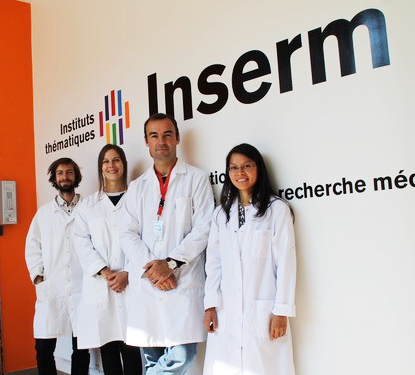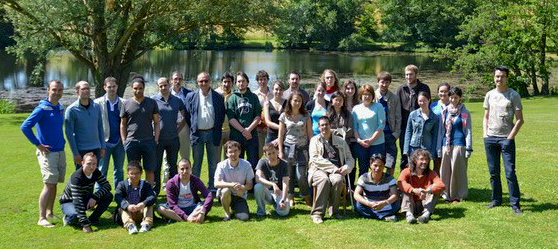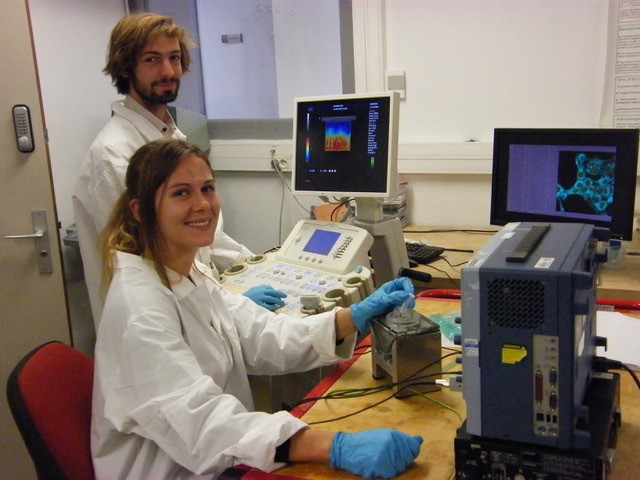The Focused Ultrasound Foundation is pleased to designate a new Center of Excellence at the French National Institute for Health and Medical Research (INSERM) in Lyon, France. INSERM Unit 1032, the Laboratory of Therapeutic Applications of Ultrasound (LabTAU), is located within a large medical and research community and conducts significant translational and clinical research with a multi-disciplinary, highly qualified, and complementary team of physicians and scientists.
 Co-led by Cyril Lafon, PhD, the Director of LabTAU, and Professor Michel Rivoire, MD, PhD, a general surgeon and the Director of the Institute of Experimental Surgery and Education at Cancer Center Léon Bérard (CLB), the Center of Excellence has special expertise in commercializing technology and creating strategic interfaces between engineering and medicine. Scientists at LabTAU have considerable experience translating focused ultrasound research from the laboratory to the bedside.
Co-led by Cyril Lafon, PhD, the Director of LabTAU, and Professor Michel Rivoire, MD, PhD, a general surgeon and the Director of the Institute of Experimental Surgery and Education at Cancer Center Léon Bérard (CLB), the Center of Excellence has special expertise in commercializing technology and creating strategic interfaces between engineering and medicine. Scientists at LabTAU have considerable experience translating focused ultrasound research from the laboratory to the bedside.
“LabTAU at INSERM is a pioneering site for research and development in focused ultrasound. They have a long history of establishing how focused ultrasound interacts with tissue, and they use that information to develop innovative clinical applications,” says Foundation Chairman Neal F. Kassell, MD. “Their laboratory research has resulted in a number of commercially available products– including those used for the first focused ultrasound treatment for patients with prostate cancer and the first opening of the blood-brain barrier in humans.”
Soon after LabTAU was chartered in 1985, it became a leader in the field of therapeutic ultrasound with the Ablatherm project conducted by Jean-Yves Chapelon, PhD, and Professor Albert Gelet, MD, PhD. This was the first project to design a method and device to use high-intensity focused ultrasound for the treatment of prostate cancer (published in 1993). “The project was initiated in 1989 between LabTAU, the University Hospital of Lyon (Edouard Herriot Hospital, HEH), and the company Technomed (now EDAP-TMS),” explains Chapelon. “The first patient with prostate cancer was treated with transrectal focused ultrasound at HEH in February 1992. Now, more than 50,000 patients have been treated worldwide.”
Creating New Medical Device Companies
 LabTAU has a long and successful history of technology commercialization. To ensure that the results of their research benefit patients, the Lab has obtained ISO 9001 certification, the highest standard in quality control. Over the past 27 years, they have been involved in the development of the technology that has led to the creation of four new focused ultrasound companies, including EDAP-TMS, Theraclion, EyeTechCare, and Carthera.
LabTAU has a long and successful history of technology commercialization. To ensure that the results of their research benefit patients, the Lab has obtained ISO 9001 certification, the highest standard in quality control. Over the past 27 years, they have been involved in the development of the technology that has led to the creation of four new focused ultrasound companies, including EDAP-TMS, Theraclion, EyeTechCare, and Carthera.
EDAP-TMS was formed in 1994 with the fusion of EDAP and Technomed. Their Ablatherm device is one of two FDA-approved systems for high-intensity focused ultrasound treatment of prostate tissue. Clinicians and researchers at LabTAU maintain a close relationship with the company to evolve new and more powerful versions of the device (e.g., integrated imaging) and were instrumental in creating and marketing the company’s second device, Focal One, for focal ablation in the prostate.
Theraclion is a company that spun off from EDAP-TMS in 2004 for the treatment of thyroid nodules and breast fibroadenoma. Having earned the CE Mark for both uses, their Echopulse device allows non-invasive tumor treatment through ultrasound-guided focused ultrasound. The company has grown to include 34 employees, half of whom are dedicated to R&D and clinical trials.
In 2008, EyeTechCare was founded to provide a new treatment for glaucoma, and their EyeOP1 device uses focused ultrasound to reduce the intraocular pressure that causes nerve damage to the eye. The piezo-electric transducers in EyeOP1 were designed for a conformal treatment of the ciliary bodies in the eye. The device and its software allow the ophthalmologist to easily and safely perform the procedure in less than three minutes.
LabTAU officially entered the field of ultrasound-enhanced drug delivery in 2010 with the formation of Carthera. In partnership with Professor Alexandre Carpentier at the University Hospitals of Paris (APHP), the joint research led to the design and development of the SonoCloud implantable device that uses pulsed focused ultrasound and microbubbles to temporarily open the blood-brain barrier to allow chemotherapy agents to reach brain tumors. Notably, Carthera conducted the first-in-man clinical trial of blood-brain barrier disruption in 2014.
A Large and Diverse Scientific Team
 LabTAU researchers include engineers, physicians, technicians, post-doctoral fellows, PhD students, and undergraduate interns. The full-time professors in biomedical engineering, mechanical engineering, and acoustics work side by side with clinicians in urology, radiology, gastroenterology, digestive surgery, and gynecology to create the transfer of laboratory research to the clinic. In total, the multi-disciplinary team of 59 individuals is comprised of 7 scientists (INSERM and CNRS) in biomedical engineering, 3 professors in mechanical engineering, 13 physicians, 13 engineers and technicians, 4 post-doctoral fellows, 19 PhD students, and a number of undergraduate interns.
LabTAU researchers include engineers, physicians, technicians, post-doctoral fellows, PhD students, and undergraduate interns. The full-time professors in biomedical engineering, mechanical engineering, and acoustics work side by side with clinicians in urology, radiology, gastroenterology, digestive surgery, and gynecology to create the transfer of laboratory research to the clinic. In total, the multi-disciplinary team of 59 individuals is comprised of 7 scientists (INSERM and CNRS) in biomedical engineering, 3 professors in mechanical engineering, 13 physicians, 13 engineers and technicians, 4 post-doctoral fellows, 19 PhD students, and a number of undergraduate interns.
The group at LabTAU is actively training young scientists. Fully affiliated with the University of Lyon, the Lab assists in the teaching and training of young scientists and physicians by providing research opportunities for students in two of the University’s doctoral programs: Interdisciplinary Science and Health (EDISS) and Mechanics (MEGA). They recently also assisted in the creation of two Master’s degree programs: one in oncology (the only Master’s degree program in France that is entirely devoted to cancer) and one in acoustics. Furthermore, LabTAU faculty teach biomedical engineering at the University of Lyon along with teaching various medical specialties at the medical schools.
 At the PhD level, the formation of the next generation of researchers is a core objective of LabTAU. They are able to cover every area of expertise and domain of research present in the laboratory, from fundamental acoustics to clinical data analysis. This “talent pipeline” has created a strong network of collaborations, through which novel projects and funding opportunities have emerged over the years.
At the PhD level, the formation of the next generation of researchers is a core objective of LabTAU. They are able to cover every area of expertise and domain of research present in the laboratory, from fundamental acoustics to clinical data analysis. This “talent pipeline” has created a strong network of collaborations, through which novel projects and funding opportunities have emerged over the years.
Current Clinical Trials
LabTAU is participating in ongoing clinical trials with its associated companies. Researchers at the Lab provide ultrasound expertise and consultation with the companies for these hospital-sponsored trials.
“At the clinical level, our Center of Excellence is concentrated around cancer, specifically prostate cancer,” says Dr. Lafon. “Technologically, we design ultrasonic medical devices for conformal treatments of gynecologic, cardiologic, and abdominal pathologies. Preclinically, we are interested in drug delivery applications without contrast agents, which could lower regulatory hurdles and facilitate clinical transfer.”
The chart below lists the six current clinical studies:
| Company | Disease/Condition | Device | Hospital |
| Carthera | Brain tumors | SonoCloud | University Hospital of Paris, APHP |
| EDAP-TMS | Focal prostate cancer | FocalOne | University Hospital of Lyon, HCL |
| EDAP-TMS | Endometriosis | FocalOne | University Hospital of Lyon, HCL |
| EDAP-TMS | Liver hepatectomy | HIFU-AR | Cancer Center, CLB |
| EDAP-TMS | Liver metastases | HIFU-AR | Cancer Center, CLB |
| EDAP-TMS | Placenta accrete | HIFU-AR | University Hospital of Lyon, HCL |
A new Center of Interventional Radiology has recently been opened at the University Hospital of Lyon (HCL) under the direction of Pr. Olivier Rouviere, and it will soon begin additional clinical trial protocols.
Ongoing Basic Research
LabTAU has five main areas of basic research for their technological, pre-clinical, and prototype development activities. These main areas and their applications include:
- High Energy Ultrasound
Focused ultrasound thermal ablation for urologic, gynecologic, digestive, neurologic, and cardiovascular pathologies. - Low Energy Ultrasound
Neurostimulation, thrombolysis, bone reconstruction, bone metastases. - Cavitation and Therapy
Opening the blood-brain barrier/chemotherapy, sonofection, sonoporation, sonodynamic therapy, and targeted microbubbles for cancer molecular screening. - Wave and Instrumentation
Various types of elastography, prostate cancer diagnosis, ultrasonic transducer technology. - Interactions Between Ultrasound and Biological Cells
Understanding how ultrasound physically interacts with cells and then inducing and regulating these bioeffects.
Funding Sources
LabTAU has a strong track record of managing research programs sponsored by private or public funding sources. These sources include companies, the national agency for research (ANR), foundations, and the European community. During the period from 2011 through 2015, LabTAU managed 47 contracts worth a cumulative total of 4.9M€. For 2016, the contract budget was 810k€. Staff salaries are fully supported by INSERM, CNRS, CLB, University Hospital, or the University of Lyon, as all scientists and affiliated physicians are state employees. The administrative management of their funding is the responsibility of INSERM, with its local branch in Lyon. A national spinoff company of INSERM, INSERM-Transfert, manages the intellectual property (patent applications and licenses) and private partner agreements.
LabTAU benefits from the support of two laboratories of excellence, an elite French funding program: LabEx DEVweCAN and LabEx CeLya, with the aim of promoting Lyon to a global hub in the field of oncology and acoustics, respectively, and to attract new talents.
Recent Publications
Rouvière O, Chapelon JY, Crouzet S, Gelet A. Prostate Cancer Focal Therapy: Just Because You Can Does Not Mean You Should. Eur Urol. 2017 Jan;71(1):35-36.
Carpentier A, Canney M, Vignot A, Reina V, Beccaria K, Horodyckid C, Karachi C, Leclercq D, Lafon C, Chapelon JY, Capelle L, Cornu P, Sanson M, Hoang-Xuan K, Delattre JY, Idbaih A. Clinical trial of blood-brain barrier disruption by pulsed ultrasound. Sci Transl Med. 2016 Jun 15;8(343):343re2
Zorgani A, Souchon R, Dinh AH, Chapelon JY, Ménager JM, Lounis S, Rouvière O, Catheline S. Brain palpation from physiological vibrations using MRI. Proc Natl Acad Sci U S A. 2015 Oct 20;112(42):12917-21.
Dupré A, Melodelima D, Pérol D, Chen Y, Vincenot J, Chapelon JY, Rivoire M. First clinical experience of intra-operative high intensity focused ultrasound in patients with colorectal liver metastases: a phase I-IIa study. PLoS One. 2015 Feb 26;10(2):e0118212.
Aptel F, Charrel T, Lafon C, Romano F, Chapelon JY, Blumen-Ohana E, Nordmann JP, Denis P. Miniaturized high-intensity focused ultrasound device in patients with glaucoma: a clinical pilot study. Invest Ophthalmol Vis Sci. 2011 Nov 11;52(12):8747-53.
Related Articles
INSERM Director Visits Foundation, Provides Research Update (December 2016)
Leading French Researcher Joins Foundation as Merkin Fellow (July 2016)
Investigator Profile: Cyril Lafon, PhD (July 2016)
Foundation Webinar: “Translational Research toward Conformal Treatments for Prostate and Brain” (November 2015)
1st Quarter 2015 Foundation Research Award – Transesophageal Cardiac Ablation (March 2015)
